A journey through Holstein – Part Two: Something old, something new…
Story by Chris Hector & Photos by Roz Neave
In Holstein they are proud that the basis of their breeding industry is still farmers who use their horse breeding as part of their total agricultural mix. Thus, on one side of Hobe Bernhard’s barn comes a series of gentle burps, and rhythmic chewing from the brown and white dairy cows, while in the boxes on the other side, are some of the young horses that have been bred here on the farm.
But just because he is a traditional mixed farmer, don’t get the idea that Hobe is some clog wearing, Schnapps swilling peasant, he is a smart, switched on guy with a keen awareness of what is going on in the sport of showjumping, and a bloody good eye for the next magic cross.
Breeding on the Bernhard farm had started with heavy horses, but after the Second World War, the attention turned to horses for the growing market of jumping competitors, but always as part of the overall farm economy.
Hobe has nine mares of his own, and takes care of another ten for their owners. He uses frozen semen from stallions like Carthago and Carnute, and with the mares that are more difficult to get in foal, fresh semen from the local stallions.
“I use stallions that produce horses that if I don’t sell the offspring as foals, they will make nice rideable showjumpers.”
The most famous horse he has produced is Coriano. The sixteen year old stallion is by Corrado out of Hobe’s Lord / Ramiro mare, and he stands at the Holsteiner Verband Stallion Barn at Elmshorn. In 1993 Coriano passed his stallion performance test in Marbach with scores of 10.0 for character, performance ability and aptitude for jumping. He was an international star with Denmark’s Bo Kristoffersen and then won the 2003 Belgian Junior Championship with the Belgian Judy Ann Melchior before being ridden by her with success on the international circuit.
Hobe’s Lord mare is one of the jewels of his farm…
Coriano’s sire Corrado I was an international jumping megastar with Franke Sloothaak, but it is his dam, Option who proves just how essential those great mares are in any breeding program. She produced three advanced showjumpers by three different stallions: Mr Turkey Cartouche (by Caletto I), B & H Medicott Isny (by Contender) and Cariana (by Corrado I), a full-sister to Coriano. Her daughter, Zenga (by Marmor) competed successfully to intermediate level jumping, before foaling Felix Hassmann’s showjumper, Cabrio (by Corrado I). Another daughter, Kimberley (by Contender) is the dam of the licensed stallion, Crawford (by Corrado I) now also standing at Elmshorn.
 The basis of any breeding program is mares, and in Holstein, that ‘mare worship’ is at its strongest. Here they talk families, mare families – the banner of the Bernhard’s indoor school celebrates the mare line of this particular farm – 318D2.
The basis of any breeding program is mares, and in Holstein, that ‘mare worship’ is at its strongest. Here they talk families, mare families – the banner of the Bernhard’s indoor school celebrates the mare line of this particular farm – 318D2.
The first studbook, ‘1 Gestütbuch der Holsteiner Marschen’ was published in 1886, three years after the first registrations of mares took place. The system of numbering the mare lines has been unchanged since then. New family numbers are given to mares with a Holsteiner father and four generations of Holsteiners on the mother’s side.
In 1885 they started with 1777 families, today there are 515. In 1948 there were 15 000 mares in Holstein, but because of the replacement of the horse by machines for agricultural purposes, by 1960 there were only 1000.
The first mare we meet at Mr Bernhard’s is Valeska IV. She is the ‘mother’ of the stud, having produced a staggering total of 18 foals in her 24 years – including three licensed stallions, Corofino I & II and the licensing winner, Camiros. The mare herself is a half sister to the very famous, Coriano.
Hobe and Valeska
Valeska’s pedigree is sort of a mini history of Holstein jumping breeding. She is by Fernando (by Farnese out of a Consul mare) out of Option (by Lord out of a Ramiro mare).
But Hobe is prepared to move out of Holstein in search of the ultimate jumper. The next mare – herself a full-sister to Eurocommerce Berlin’s mother – is in foal to the Hanoverian jumping star, For Pleasure – while in the next stable, there’s a Contender daughter, mother of the promising young stallion, Crawford, and she is in foal to Carthago. Running free for us in the school is a very nice young mare. Hobe bought her from one of his neighbours – on her mare line she is from his stamm line, but she is in foal to the Selle Français, Diamant de Semily. Something old, something new, refreshing the mare line with blood from France.
But Hobe Bernhard doesn’t just breed to sell. Outside in the arena, his daughter, Annick, is riding a lovely six year old, by Carnute out of a Lord mare. “They keep asking me if this one is for sale?” but like any proud show dad, “this one is for my daughter to ride.”
We lunch on the best soup in Germany, kindly provided by Hobe’s wife, Doris before travelling on to see a very different operation – the private stallion farm of Maas J. Hell.
This is very much a twenty first century stud farm, the traditional wood and straw has been replaced by shiny steel and state of the art synthetic, and while the traditional Holstein breeding operation is on the small size, the stud farm Maas J Hell is large, impressively large.
There’s two great big indoors and stabling for 140 horses – with another 100 horses distributed around the neighbouring farms. There are 15 staff to keep things ticking over at this farm which stands 21 stallions – with ten leased out to other stallion stations! Last season, stallions owned by the farm bred 2500 mares – but this includes the mares bred by leased stallions, and when you consider that one of them is the very popular Hanoverian sire, Laurie’s Crusador, that adds a few to the total. Interestingly, two of the stallion roster – Quite Capitol and Cero – were bred by Harm Thormåhlen who we met in the first episode of this survey…
The late Maas J. Hell was the director of the Holstein Verband, but at the same time he was building up his own private stallion station which apparently caused a little heartburn at the time. He was celebrated as the visionary who brought ‘Corde’ (Cor de la Bryère) to Holstein, and also for vigorously promoting the influx of Thoroughbred blood in the 60’s – a development that may well have saved the Holsteiner from extinction.
He became managing director at Elmshorn in 1971, a time when the German breeding scene was at a low. Only 1200 mares were registered with the Holsteiner Verband.
When Maas J. Hell started his job, the increasing number of riders in Germany meant more horses were needed, and being a true marketing expert Maas J.Hell re-activated the sale stables at Elmshorn. Under his direction the Holsteiner approval, the show evening and the auction at Neumünster found a world wide reputation.
Maas J. Hell not only started with the marketing of Holsteiner horses, he re-organised, with great success, the stable of competition horses at Elmshorn. He found horses for the talented Herbert Blöcker, a long term employee of the Verband, who won the silver medal at the European Championships for Three Day Eventing at Kiev and the bronze medal at the Montreal Olympics. He discovered Corlandus, famous dressage horse of Margit Otto-Crépin, and Caletto I ridden by Dr. Michael Rüping. In the breeding scene it was Cor de la Bryère, who was extensively promoted by Maas J.Hell.
During that time new stables and a new riding arena were built at Elmshorn. Interminable discussions with members of the Verband and officials from the government in Schleswig-Holstein made it possible to build a very functional building without burdening the members unduly.
Early success came with Athlet Z
Having left the Holsteiner Verband in the early eighties, Maas J. Hell started with his own stallion business with an internationally renowned breeding yard. His great knowledge of horses and Holsteiner dam lines made it a huge success. Maas J. Hell had his greatest success with Ahorn Z and Athlet Z, both sons of Almé, and Cantus by Caletto I.
In 1997 Maas J. Hell died in the age of 63. As manager of the Holsteiner Verband, as a private stallion owner and as a famous horse dealer, he had put his stamp on the Holsteiner breed.
After Hell’s death, Thomas Mohr took over the direction of the Stud. Born in 1962 Thomas Mohr got his first pony when he was six years old. His very successful riding career at horse shows started when he was 12 years old. After finishing school he began with his education to become a professional rider.
After having finished his apprenticeship he started work with the Holsteiner Verband, where he met Mass J. Hell, at that time manager at Elmshorn. They immediately got on very well and a very strong friendship based on confidence and respect started. One year later Maas J Hell resigned as managing director at Elmshorn and Thomas Mohr followed him to his private stable at Klein Offenseth. Maas J. Hell started to build up a small but very exclusive showing and breeding yard.
Thomas Mohr produced many sport horses such as Chin Chin (Jaime Azcarraga), Calais Joter and Cassiana (both successful under André Johannpeter), Athletico (Ludger Beerbaum &. Ralf Schneider) and the unforgettable Calvaro with Willi Melliger. Thomas also had the honour of riding the great Accord II when he was the reserve champion at the Bundeschampionat.
Maas J. Hell believed that it was important to compete his breeding stallions in order to prove their willingness to perform, and their athleticism. The Bundeschampionat at Warendorf became more and more a show-case for stallion owners, and stallions like Acord II and Calido I qualified for the finals. Thomas Mohr followed the proven formula.
The stallions are still out competing to show the world what they can do. Thomas Mohr’s special interest is in breeding a blood (ie. Thoroughbred) type horse, easy to ride with a correct and functional way of moving in accordance of today’s requirements of the sport.
Despite of all the sceptics Thomas Mohr succeeded in continuing the success of the breeding station. Stallions such as Acorado I , Quite Capitol , Singulord Joter , Quebec and Concept are competing now internationally after having been in the finals of the Bundeschampionat.
The Brazilian Dr. Jorge Johannpeter had been a long time client of Maas J. Hell. Thomas Mohr continued this close relationship and Bernardo Alves, sponsored by Johannpeter, took the ride on Canturo. They won international Grand Prix and took part at the Olympics 2004 and WEG 2006.
In the meantime offspring of the Kl. Offenseth stallions are at home world-wide.
Thomas Mohr pays tribute to the stallions put in place by his predecessor:
“It started off with the two Almé sons, Ahorn and Athlet. There were many sport horses by Athlet, they were not always easy to ride, they had a strong character. The horses by Ahorn were easy to ride. Then came Cantus and Landadel.”
“Cantus was for 15 years one of the most successful showjumping sires – with horses like Calvaro with Willi Melliger. The horses by Cantus were very powerful and easy to ride, sometimes not the prettiest horses, but very willing to perform.”
“Landadel, was not accepted for the stallion licensing at Neumünster by the Holsteiner commission, they said he was too light – a good sport horse not a stallion!”
“So then he was leased to Böckmanns, and they bred with him for about ten years before he died, and every year he was in the top three for jumping sires, but he also bred dressage horses. Most of the foals went to S class. Calvaro and Landadel were from the same family – Landadel’s dam was Calvaro’s grand mother.”
“The Landadel mares were very typey, with a lot of blood. The geldings and stallions were a bit bigger, not so Thoroughbred looking as the mares. In the back of Landadel’s pedigree is Farnese, and Farnese is very heavy.”
After Landadel – who were the next important stallions?
“Acord, Calido, Laurie’s Crusador, Cantus. Acord was the sire of many stallions. He won the stallion test as a four year old because he had been operated on as a three year old for colic. He was second in the five year old class at the Bundeschampionat, and he had many mares as a five and six year old. His foals were very typey and the rideability was very good – they were easy to handle. Last year more than 45 Acords were placed at S level in Germany. Calido had 60 placegetters at S. Acord is 20 years old now. Calido is 16. The offspring of Calido are very pretty, very beautiful – and everyone can ride them, amateur or professional.”
It’s lucky that Laurie’s Crusador went to Celle, because he would have been very lonely with all these jumping stallions?
“He was not approved in Holstein. We couldn’t try him jumping because he had broken his fetlock. We rode him but we didn’t want to jump him because of this injury. God wanted him to go to Celle.”
The stallions at your station, they are not like the idea of Holsteiner horses in the past – heavy, and not so pretty…
Acordetto – modern and very pretty…
“This is a new generation, but in the past 15 years, we have changed the type, because the market wants beautiful, typey, horses, the refined horses. Many customers come from abroad, like France and Italy, and many of these customers are girls – about 60% – so ride-ability is very important, and they need a blood type horse. There is also the climate, it is 30 / 40 degrees there, what do you want with a big, fat horse? But it should stay a Holsteiner horse, we want to keep the Holsteiner type, we don’t want a narrow horse, and not with too much blood. We want to keep to our type of horse, and that is the difficulty, to keep the balance – between a blood horse, and one with lots of power.”
Do the breeders here want to breed to the new young stallions or to the older established horses?
“A proper breeder, he uses also the young stallions. The problem is that the breeders from the country are getting less and less, and we have new breeders who do it as a hobby, and they want to have a stallion that they have seen on the TV competing in big competitions, or a 15 year old stallion whose progeny have shown what he can do. But sometimes the mare does not fit to this stallion.”
But in Hanover and Oldenburg the hobby breeders want to breed to last year’s licensing winner…
“That is an advantage in Holstein, we know that winning the licensing is only for one day – the horse showed well on that very important day, but there might be better stallions that were third or fourth, but they didn’t have such a good day as the winning stallion.”
Have you gone back to France for more jumping blood?
“Last week I bought a yearling by Le Tot de Semilly out of a mare by Galoubet, who comes from the mother of Cor de la Bryère. It is very difficult to find a four or five year old stallion in France, they are very expensive and the quality is not there – it is easier to buy them as yearlings or two year olds, and take the risk.”
And like everyone in the world, I guess you are looking for a Thoroughbred jumping stallion?
“German Thoroughbred breeding has changed with the Northern Dancer blood, more like Quarter horses – we need the big framed Thoroughbreds but they are difficult to find. We bought six from New Zealand fifteen years ago – they were very nice horses but none of them was a stallion. Nice horses for eventing and showjumping competition. We should look everywhere, Australia, Argentina, perhaps Russia. You have to be lucky to find the right full blood stallion. When you think you have found the right type of Thoroughbred stallion, you still don’t know if his offspring are going to work.”
What do you think Contender gave to Holstein breeding?
“He has proven what he has for the breed, he gives lots of power. He is the sire of many horses on the international showjumping scene. He is a great stallion, you either like him or you don’t like him, but he has set his footmark. He is comparable to Grannus in Oldenburg, or Pilot in Westphalia, but he needs a special mare, a blood type mare. Each stallion needs a special mare.”
“That’s the problem with the hobby breeders – if they have a good mare, they want to breed her to Contender, but everybody knows it doesn’t fit, because the mare is heavy. That’s the difference with the older breeders, you can say to them, ‘don’t do that’, and they take the advice.”
Thomas is a qualified traditionalist:
“It is very important that Holstein is open for special bloodlines but not for all bloodlines like they do in Oldenburg. The best thing is for us to stick to proven jumping lines because in Oldenburg and Hannover, they have mixed up their jumping families with dressage stallions and what they produce is not meat or fish!”
“Sure we should recognize good Thoroughbred or French blood, that is the way to go, but we have to do it carefully – don’t worry about all the talk of too much ‘C’ blood in Holstein – because what are the jumpers in Hannover? What are the jumpers in Holland? Holsteiner blood, ‘C’ line blood. Look at Calypso II and what he did for Hannover!”
“Everywhere where they breed jumpers they need Holsteiner blood, and it is going to be more extreme in a few years, because the dressage stallions are breeding up to 600 mares in a season, and what are they going to do for jumping blood in the future? Right now, 60/70% of the jumpers out competing have Holstein blood.”
You get the feeling that Thomas is happier on his feet showing off his stallions than he is sitting down and being quizzed, and he beams with delight as he shows off the young stallion that’s working in the indoor school – Contefino. By Contender and out of a mare by Corofino, the horse was sold as a foal to the United States, now eight years old he is back in Germany (funny that, if they sell a brilliant horse by mistake, the Germans are very quick to get it back!) The super jumper already has five placings at S level, and has obviously impressed some of the good judges – he already has 30 mares in foal on Paul Schockemöhle’s farm.
Thomas shows off Contefino
There are a couple of local farmers on hand – they have narrowed their stallion selection down to a smallish group, but first they want to see the stallions trotting out on the hard bitumen road, and the stud master duly obliges.
The first stallion we see is one of the established stars, Calido – a son of Cantus, who died far too early in 1994 but not before he produced winners of 1.35 million! Since Calido I’s sire Cantus is out of a mare by Roman and his grandam is by Roman too, he is closely bred to the grey stallion, who was bred by Martin Thormählen.
Calido I earned the maximum score of 10.0, as well as the highest jumping index out of a total of 53 colts in the 1994 performance test at Adelheidsdorf. Almost 20 of his sons have been approved, and 19 daughters were awarded the state premium.
They also trot out Quite Capitol – he is an interesting mixture of old and new, being by the Danish based French sire, Quidam de Revel out of one of the famous mares at the Thormählen farm, U-Capitola, the full-sister to the famous Capitol. Quite Capitol is still owned by Harm Thormählen, but stands at Maas J. Hell.
Quite Capitol was runner-up at the 2001 Holstein approval in Neumünster. At the 2004 Bundeschampionat he carried Torben Köhlbrandt to victory in both qualifying rounds before finishing in eighth place.
Then comes one of the most beautiful stallions I have ever seen, Singlulord Joter, who despite being bred in Brazil, is solidly Holsteiner. He is by Singular Joter who combines the blood of the Selle Français Silbersee with the Holstein stalwarts Ramiro and Farnese, out of a Brazilian mare who carries the blood of Athlet Z, Cor de la Bryère and Silbersee, along with the Thoroughbreds, Ladykiller and Sacramento Song. The six year old is not just a pretty face – in his 70 day test he twice scored 10 for his jumping, and in 2006 was 3rd at the Bundeschampionat.
Singulord Joter
Like most of the other major studs in Germany, Maas J. Hell puts on a flashy big stallion show, but it is nice to see that the local breeders want the traditional big trot on the bitumen road before they make their decision – traditions die hard in Holstein, maybe that’s their strength?
Next month we talk with the Holstein director, Norbert Boley….




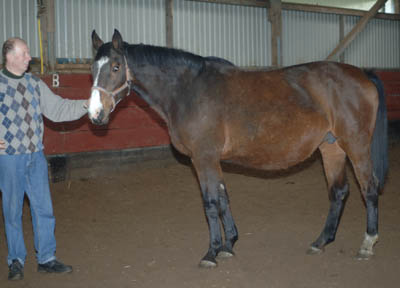
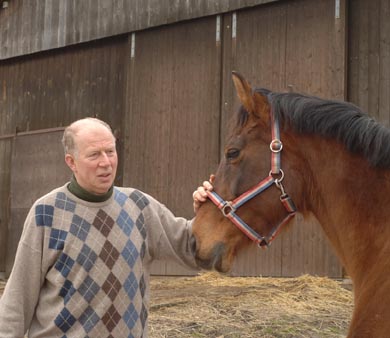

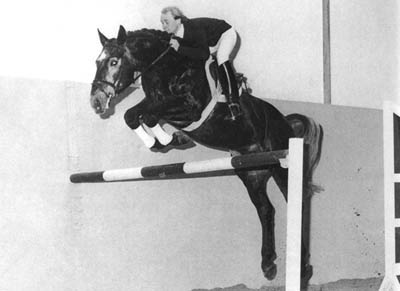
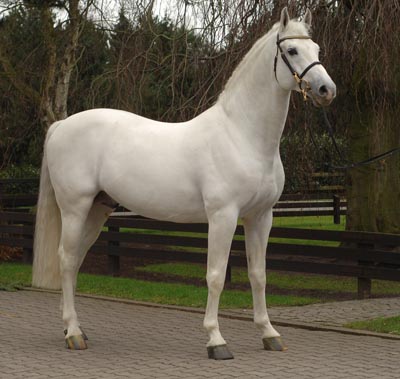
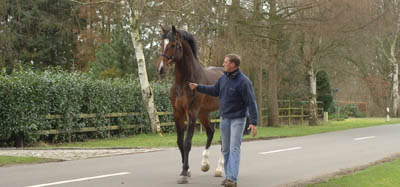
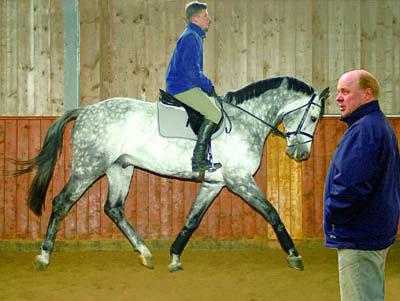
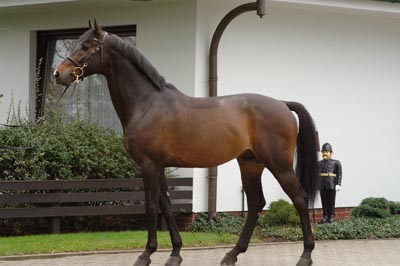

I saw a son of Singulord Joyer competing yesterday, he was fab, does anyone know of any offspring for sale?
I will have next year by Casall – Lansing mare (https://www.youtube.com/watch?v=qcf7tQAHJqo) ….
and I can’t wait 🙂